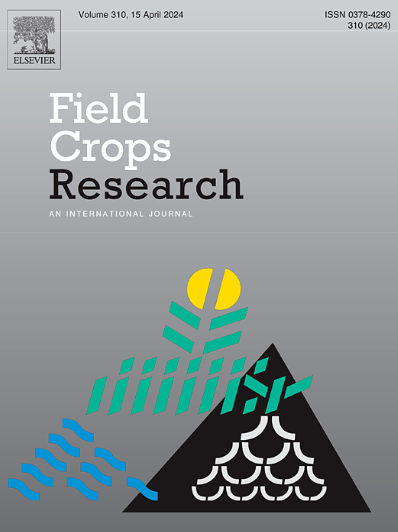Early drought stress triggers contrasting trait responses in spring barley
IF 6.4
1区 农林科学
Q1 AGRONOMY
引用次数: 0
Abstract
Context
Drought stress tolerance in plants, a complex trait influenced by various factors, poses significant challenges for breeding. Increasingly frequent droughts during early plant development emphasize the need to understand how traits interact under stress conditions.
Research question
This study aims to investigate traits of interest for early drought stress tolerance and the relationship of physiological and yield-related traits in spring barley.
Methods
A diverse set of barley genotypes were grown under greenhouse and field conditions using a rainout-shelter for two years. Drought stress was applied at the third leaf stage with soil water capacity set at 20 %, while the control group was watered until 50 %. Traits such as stomatal conductance, proline content, and yield (here grain biomass) were analyzed.
Results
Results showed high genotypic variation in traits like plant biomass, water use efficiency, and grain biomass under early drought stress. Notably, proline content was negatively correlated with grain biomass (r = -0.66). Plant height had the highest heritability (h² = 0.96), and both plant height and grains per ear had strong correlations between greenhouse and field conditions (r = 0.78 and r = 0.84).
Conclusion
Early drought tolerant genotypes were identified by their fast adaptation to re-watering through high water use, while sensitive genotypes were characterized by elevated proline content.
Significance
Understanding the response and relationship between physiological and yield-related traits is crucial for selecting barley lines with improved early drought tolerance for breeding.
早期干旱胁迫触发春大麦性状响应的差异
植物的抗旱性是一种受多种因素影响的复杂性状,对育种提出了重大挑战。在植物早期发育期间日益频繁的干旱强调了了解胁迫条件下性状如何相互作用的必要性。本研究旨在探讨春大麦早期抗旱特性及其生理和产量相关性状之间的关系。方法对不同基因型的大麦在温室和大田条件下进行了两年的栽培试验。在第三叶期进行干旱胁迫,土壤水分容量设定为20% %,而对照组则浇水至50% %。分析气孔导度、脯氨酸含量和产量(这里是籽粒生物量)等性状。结果在早期干旱胁迫下,植物生物量、水分利用效率和籽粒生物量等性状发生了较大的基因型变异。脯氨酸含量与籽粒生物量呈显著负相关(r = -0.66)。株高遗传力最高(h²= 0.96),株高和穗粒数在温室条件和田间条件下具有较强的相关性(r = 0.78和r = 0.84)。结论早期抗旱基因型通过高水分利用快速适应复水,而敏感基因型以脯氨酸含量升高为特征。了解生理性状与产量性状的响应及其相互关系,对选育早期耐旱性提高的大麦品系具有重要意义。
本文章由计算机程序翻译,如有差异,请以英文原文为准。
求助全文
约1分钟内获得全文
求助全文
来源期刊

Field Crops Research
农林科学-农艺学
CiteScore
9.60
自引率
12.10%
发文量
307
审稿时长
46 days
期刊介绍:
Field Crops Research is an international journal publishing scientific articles on:
√ experimental and modelling research at field, farm and landscape levels
on temperate and tropical crops and cropping systems,
with a focus on crop ecology and physiology, agronomy, and plant genetics and breeding.
 求助内容:
求助内容: 应助结果提醒方式:
应助结果提醒方式:


